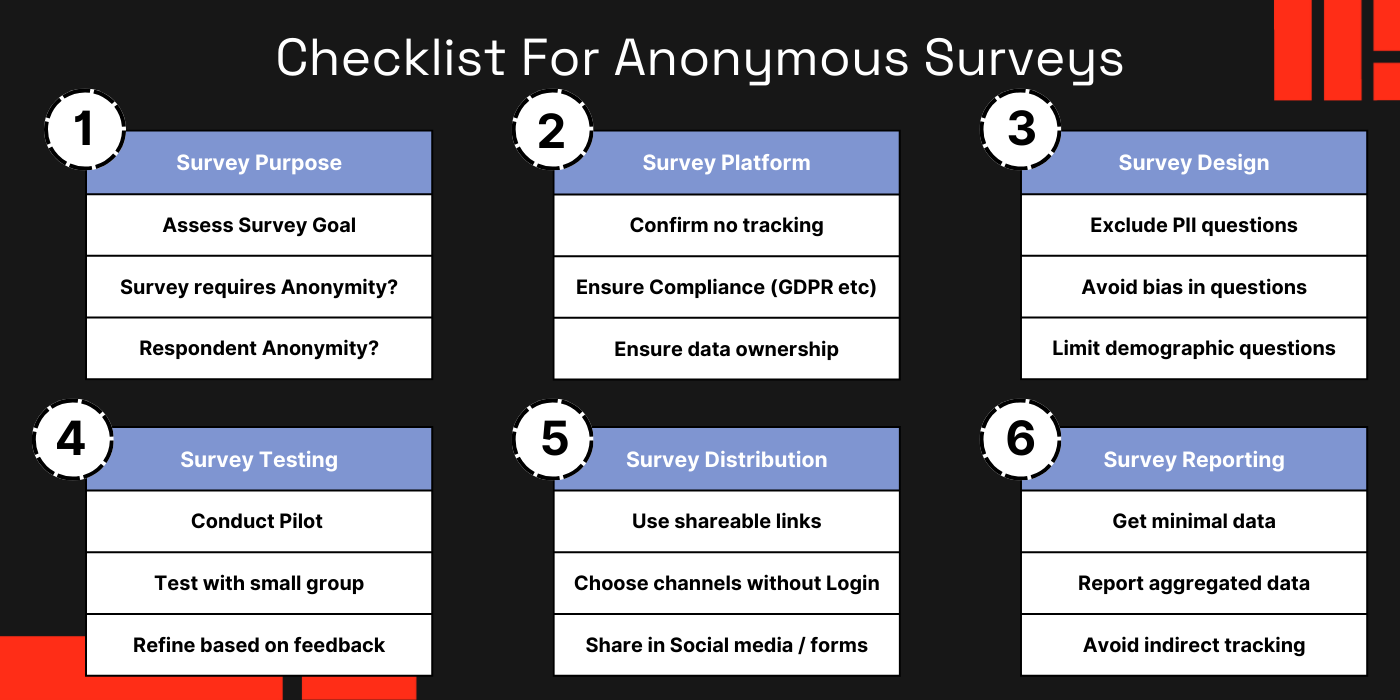Get insights.
Unlock value.
- 14-day free trial
- Set up in minutes
- No credit card required
The Ultimate Checklist For Anonymous Survey
We understand that you care for your respondents anonymity, and you’re here to double check what you are going to roll out. Even the smallest oversight can compromise respondent privacy and undermine the trust you've worked hard to build.
Whether you're gathering sensitive feedback, conducting market research, or running an internal employee survey, the promise of anonymity can significantly boost participation rates and the honesty of responses.
But how can you be absolutely sure that your survey truly protects the identity of your respondents?
Here we discuss the essential checklist for Anonymous Survey. This checklist will ensure you build trust with your audience and also gather more actionable insights.
Let’s dive in.
Check if Survey Purpose calls for Anonymity
Not all surveys call for Anonymity. Therefore it is important to deeply understand the purpose of the survey.
- It helps to understand the goal of the survey. If the goal of the survey is to capture employee feedback, it signals the need for anonymous surveys.
- Get to know the respondents of the survey. For example, if drug consumers are the respondents of the survey, it calls for anonymity while conducting the survey.
- There is an immense need to keep track of the sensitivity level of the survey. Let’s say if the survey is regarding sex workers and their lifestyle, this demands anonymity.
As a first step, make sure to check survey purposes while planning for an Anonymous survey.
Choose Anonymous Survey Platform
- Data privacy: The Platform should have utmost privacy policies, especially on how it handles the data. This means the platform should not store or access personal identifiers or sensitive information that could compromise anonymity.
- Compliance with high privacy standards: The platform should comply with stringent privacy regulations, such as GDPR, HIPAA, CCPA, or other relevant laws. This ensures that the survey tool follows best practices for data protection and respects respondent privacy on a global scale.
- No trackers,No IP collection: It must guarantee anonymity by not track respondents through cookies, web trackers, or collect IP addresses. This is crucial for preventing the possibility of linking responses back to individual users.
- Decentralized data storage: Centralized storage always has the risk of data breaches or loss of sensitive data, so decentralized storage reduces the risk of data breaches
- Data accessibility: The survey creator should have the complete access to the data, the ownership should remain and locked with the survey creator. Even the platform should not be able to access it by any means. This minimizes the risk of unauthorized access and ensures that data remains confidential and secure.
- End-to-end encrypted: End-to-end encryption is a critical feature that ensures data is encrypted at all stages during transmission and while stored.
You might be surprised to know that BlockSurvey is the only platform that stands out to be completely Anonymous survey platform by ticking all the items from the above checklist. Now we’ll move on to ensuring anonymity in your survey design.
Avoid the questions that are connected to PII in survey design
When designing the survey avoid the questions that might collect Personally Identifiable Information (PII).
- Questions related to PII should be avoided.(Name, Address, Phone or any other identifying information)
- Ask the questions that are neutral and cannot point back to respondents.
- Make sure the question are unbiased and does not push the participants towards particular answer.
Keep these points in mind while creating the questions to support anonymity and improve data quality.
Test It Before Sharing
Before sharing the survey, conduct a pilot test to make sure there are no issues in design or questions.
- Test it with a small group of your target audience to ensure clarity and functionality. This also helps avert costly mistakes at the later stages of the survey.
- Using the feedback from the pilot test, refines the survey design. You can make necessary changes to the question at this stage and make sure no Personally identifiable Information is collected.
This will help to preserve the anonymity of surveys, and ensure need is met.
Communicate the Anonymity and Compliance
Clear & Transparent Communication regarding how the survey is conducted builds trust with the respondents. The participants need not make any assumptions about the survey.
- If you are regulation-compliant, communicate your compliance with the respondents. For example, when you are GDPR or HIPAA compliant, it helps to build trust, when you communicate the same.
- It is a good practice to maintain privacy policy. If you don’t have a privacy policy in place, consider creating one. Provide a link to privacy policy in your survey’s welcome screen.
Distributing survey securely
The distribution part plays a major role in preserving anonymity.
- Make sure that the survey links you share don’t track the respondents’ data, such as name, IP addresses or location.
- Choose distribution channels that don’t require login to further ensure their anonymity. Social media and anonymous forums are appropriate places to share anonymous surveys.
Response Analysis & Reporting
Analysis and reporting are the final stages of your survey.
- It is important to maintain a minimal data policy. This means you are called to only collect and analyze data necessary for the survey objective. In this way, you avoid collecting unnecessary information from respondents, which may reveal their identity.
- It is to be noted that sometimes even demographic information can track the respondent identity. Reporting your data in aggregated form is a good practice to avoid indirect tracking of respondent identity.
The below checklist highlights important points to consider when creating Anonymous Surveys. This can be a handy reference.

To Wrap It Up
Now you can understand creating a truly anonymous survey doesn’t end with not asking personal questions alone, it is far more specific starting from choosing the right tool, configuring them to communicating them properly. This checklist is all you need to showcase your dedication to protecting your respondents, you'll not only gather more authentic data but also foster a stronger, more trusting relationship with your audience.
If you want to take anonymity to the next level, create your first completely anonymous survey using BlockSurvey, explore how the data stays private and anonymous.
The Ultimate Checklist For Anonymous Survey FAQ
Why is anonymity important in surveys?
Anonymity encourages honest responses and builds trust, leading to more accurate insights.
How can I ensure my survey platform is truly anonymous?
Choose a platform with strict privacy policies, no IP tracking, compliance with regulations (like GDPR), and end-to-end encryption, such as BlockSurvey.
What types of surveys require anonymity?
Surveys on sensitive topics, like employee feedback, drug use, or marginalized lifestyles, typically require anonymity.
How can I communicate the anonymity of my survey to participants?
Clearly explain data handling and anonymity in the survey introduction, and link to your privacy policy.
What steps should I take before distributing my survey to ensure anonymity?
Conduct a pilot test, avoid collecting Personally Identifiable Information (PII), and use secure, non-tracking distribution channels.
Get insights.
Unlock value.
- 14-day free trial
- Set up in minutes
- No credit card required

